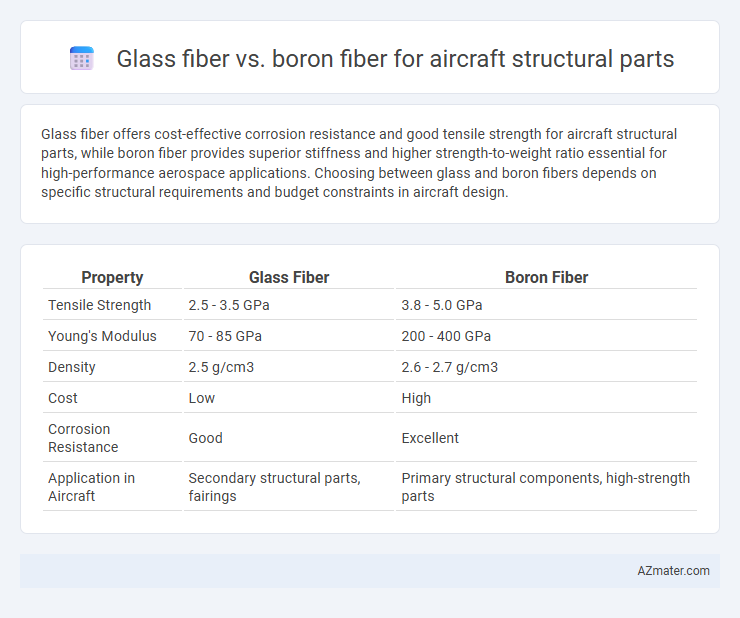Glass fiber offers cost-effective corrosion resistance and good tensile strength for aircraft structural parts, while boron fiber provides superior stiffness and higher strength-to-weight ratio essential for high-performance aerospace applications. Choosing between glass and boron fibers depends on specific structural requirements and budget constraints in aircraft design.
Table of Comparison
| Property | Glass Fiber | Boron Fiber |
|---|---|---|
| Tensile Strength | 2.5 - 3.5 GPa | 3.8 - 5.0 GPa |
| Young's Modulus | 70 - 85 GPa | 200 - 400 GPa |
| Density | 2.5 g/cm3 | 2.6 - 2.7 g/cm3 |
| Cost | Low | High |
| Corrosion Resistance | Good | Excellent |
| Application in Aircraft | Secondary structural parts, fairings | Primary structural components, high-strength parts |
Introduction to Composite Fibers in Aviation
Glass fiber and boron fiber are critical composite materials used in aircraft structural parts, each offering unique mechanical properties. Glass fiber provides excellent corrosion resistance and cost-effectiveness, making it ideal for non-load-bearing components, while boron fiber delivers superior stiffness and strength-to-weight ratios crucial for primary load-bearing structures. The integration of these fibers in aviation composites enhances aircraft performance by optimizing durability, weight savings, and structural integrity.
Overview of Glass Fiber in Aircraft Structures
Glass fiber offers high tensile strength and excellent corrosion resistance, making it a preferred choice for non-critical aircraft structural components such as fairings and interior panels. Its lightweight nature and cost-effectiveness contribute to improved fuel efficiency and reduced manufacturing expenses in aerospace applications. However, glass fiber's lower stiffness compared to boron fiber limits its use in high-performance load-bearing parts where exceptional strength-to-weight ratios are crucial.
Overview of Boron Fiber in Aircraft Structures
Boron fiber offers exceptional stiffness and high tensile strength, making it ideal for aircraft structural components that require lightweight yet durable materials. Its superior modulus of elasticity and fatigue resistance surpass glass fiber, enhancing aircraft performance and longevity. Boron fiber composites enable weight reduction while maintaining structural integrity in critical aerospace applications.
Mechanical Properties: Glass Fiber vs Boron Fiber
Boron fiber exhibits superior tensile strength and stiffness compared to glass fiber, making it highly suitable for aircraft structural parts requiring high load-bearing capacity and minimal weight. Glass fiber, while less stiff and strong, offers better impact resistance and is more cost-effective for less critical structural components. The high modulus of elasticity of boron fiber significantly enhances fatigue resistance and dimensional stability in aerospace applications.
Weight and Density Comparison
Glass fiber has a density of approximately 2.5 g/cm3, whereas boron fiber is denser, around 2.6-2.8 g/cm3, impacting the overall weight of aircraft structural parts. Boron fiber exhibits higher stiffness and strength-to-weight ratio, allowing for thinner and lighter components despite its slightly higher density. The choice between glass and boron fiber balances the trade-off between material density and mechanical performance for optimal weight reduction in aerospace applications.
Durability and Corrosion Resistance
Boron fiber exhibits superior durability and stiffness compared to glass fiber, making it ideal for critical aircraft structural parts subjected to high stress. Both fibers offer excellent corrosion resistance, but boron fiber's metallic nature can lead to galvanic corrosion if not properly insulated, whereas glass fiber provides consistent non-metallic corrosion resistance. Selecting boron fiber requires additional protective measures to ensure long-term structural integrity in aircraft environments.
Manufacturing and Processability
Glass fiber offers superior manufacturability for aircraft structural parts due to its ease of handling, cost-effectiveness, and compatibility with a wide range of resin systems, enabling efficient mass production through processes such as filament winding and resin transfer molding. Boron fiber, while providing higher strength-to-weight ratios, presents significant challenges in processing because of its brittleness, higher cost, and the need for specialized equipment and protective handling to avoid fiber damage during composite layup and curing. Manufacturing aircraft components with glass fiber reduces lead times and fabrication complexities compared to boron fiber, which demands more stringent quality controls and process precision.
Cost Analysis: Glass Fiber vs Boron Fiber
Glass fiber offers a significantly lower cost option for aircraft structural parts compared to boron fiber, with raw material prices approximately 5 to 10 times less expensive. Boron fiber, while providing superior stiffness and strength-to-weight ratios, incurs high manufacturing and handling costs, limiting its use to critical load-bearing components in aerospace applications. Cost-benefit analysis favors glass fiber for large-area structures where budget constraints dominate, whereas boron fiber is reserved for performance-critical sections where its mechanical advantages justify the premium expense.
Applications in Modern Aircraft Design
Glass fiber offers high tensile strength and corrosion resistance, making it suitable for aircraft interior components and secondary structural parts where cost-efficiency is critical. Boron fiber, characterized by superior stiffness and excellent fatigue resistance, is extensively utilized in primary structural elements such as wing spars and fuselage reinforcements for high-performance military and commercial aircraft. Modern aircraft design increasingly leverages boron fiber composites to reduce weight and enhance durability, while glass fiber remains preferred for non-critical applications due to its lower cost and ease of manufacturing.
Conclusion: Choosing the Optimal Fiber for Aircraft Structures
Boron fiber offers superior stiffness and strength-to-weight ratio compared to glass fiber, making it ideal for critical aircraft structural parts where performance and weight reduction are paramount. Glass fiber remains a cost-effective option with excellent corrosion resistance and impact toughness suitable for less critical components. The optimal fiber choice ultimately depends on balancing mechanical requirements, environmental conditions, and budget constraints.

Infographic: Glass fiber vs Boron fiber for Aircraft structural part
 azmater.com
azmater.com